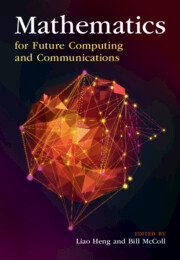Refine listing
Actions for selected content:
9096 results in Communications, Signal Processing and Information Theory
10 - Correction of Error-Bursts and Erasures
-
- Book:
- Fundamentals of Classical and Modern Error-Correcting Codes
- Published online:
- 02 February 2022
- Print publication:
- 09 December 2021, pp 367-405
-
- Chapter
- Export citation
2 - Some Elements of Modern Algebra and Graphs
-
- Book:
- Fundamentals of Classical and Modern Error-Correcting Codes
- Published online:
- 02 February 2022
- Print publication:
- 09 December 2021, pp 25-88
-
- Chapter
- Export citation

Mathematics for Future Computing and Communications
-
- Published online:
- 03 December 2021
- Print publication:
- 16 December 2021
11 - Unimodal Models
- from GENERATIVE MODELS
-
- Book:
- Machine Learning Fundamentals
- Published online:
- 18 November 2021
- Print publication:
- 25 November 2021, pp 239-256
-
- Chapter
- Export citation
Notation
-
- Book:
- Machine Learning Fundamentals
- Published online:
- 18 November 2021
- Print publication:
- 25 November 2021, pp xvii-xviii
-
- Chapter
- Export citation
2 - Mathematical Foundation
-
- Book:
- Machine Learning Fundamentals
- Published online:
- 18 November 2021
- Print publication:
- 25 November 2021, pp 19-66
-
- Chapter
- Export citation
7 - Learning Discriminative Models in General
- from DISCRIMINATIVE MODELS
-
- Book:
- Machine Learning Fundamentals
- Published online:
- 18 November 2021
- Print publication:
- 25 November 2021, pp 133-150
-
- Chapter
- Export citation
GENERATIVE MODELS
-
- Book:
- Machine Learning Fundamentals
- Published online:
- 18 November 2021
- Print publication:
- 25 November 2021, pp 219-220
-
- Chapter
- Export citation
12 - Mixture Models
- from GENERATIVE MODELS
-
- Book:
- Machine Learning Fundamentals
- Published online:
- 18 November 2021
- Print publication:
- 25 November 2021, pp 257-290
-
- Chapter
- Export citation
Bibliography
-
- Book:
- Machine Learning Fundamentals
- Published online:
- 18 November 2021
- Print publication:
- 25 November 2021, pp 381-396
-
- Chapter
- Export citation
8 - Neural Networks
- from DISCRIMINATIVE MODELS
-
- Book:
- Machine Learning Fundamentals
- Published online:
- 18 November 2021
- Print publication:
- 25 November 2021, pp 151-202
-
- Chapter
- Export citation
9 - Ensemble Learning
- from DISCRIMINATIVE MODELS
-
- Book:
- Machine Learning Fundamentals
- Published online:
- 18 November 2021
- Print publication:
- 25 November 2021, pp 203-218
-
- Chapter
- Export citation
15 - Graphical Models
- from GENERATIVE MODELS
-
- Book:
- Machine Learning Fundamentals
- Published online:
- 18 November 2021
- Print publication:
- 25 November 2021, pp 343-374
-
- Chapter
- Export citation
5 - Statistical Learning Theory
- from DISCRIMINATIVE MODELS
-
- Book:
- Machine Learning Fundamentals
- Published online:
- 18 November 2021
- Print publication:
- 25 November 2021, pp 97-106
-
- Chapter
- Export citation
DISCRIMINATIVE MODELS
-
- Book:
- Machine Learning Fundamentals
- Published online:
- 18 November 2021
- Print publication:
- 25 November 2021, pp 95-96
-
- Chapter
- Export citation
Preface
-
- Book:
- Machine Learning Fundamentals
- Published online:
- 18 November 2021
- Print publication:
- 25 November 2021, pp xi-xvi
-
- Chapter
- Export citation
4 - Feature Extraction
-
- Book:
- Machine Learning Fundamentals
- Published online:
- 18 November 2021
- Print publication:
- 25 November 2021, pp 77-94
-
- Chapter
- Export citation
6 - Linear Models
- from DISCRIMINATIVE MODELS
-
- Book:
- Machine Learning Fundamentals
- Published online:
- 18 November 2021
- Print publication:
- 25 November 2021, pp 107-132
-
- Chapter
- Export citation
14 - Bayesian Learning
- from GENERATIVE MODELS
-
- Book:
- Machine Learning Fundamentals
- Published online:
- 18 November 2021
- Print publication:
- 25 November 2021, pp 311-342
-
- Chapter
- Export citation
A Other Probability Distributions
- from APPENDIX
-
- Book:
- Machine Learning Fundamentals
- Published online:
- 18 November 2021
- Print publication:
- 25 November 2021, pp 377-380
-
- Chapter
- Export citation
